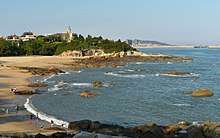Chongwu
Understand

Located on a sandy peninsula jutting into Taiwan Strait, Chongwu is a popular getaway for residents of Quanzhou. It has pleasant beaches and a scenic old walled town. The Chongwu fortress (the name, 崇武, can be interpreted as "Honoring the warriors"), is one of the numerous fortresses that were built along China's southwestern coast during the reign of the Ming Dynasty's founder, the Hongwu Emperor, in the late 14th century, to defend the nation's coastal regions from the wokou pirates. While some other forts, in various states of decay or repair, can be visited elsewhere (e.g. Pucheng in Cangnan County south of Wenzhou, or Liu'ao in Zhangpu south of Xiamen), Chongwu is, arguably, the most attractive of the lot, due to its scenic setting and the town's traditional stone archicture.
Get in
Train
The Hui'an railway station, on the Fuzhou-Xiamen high-speed rail line, is 33 km to the northwest. Direct bus service from the station to Chongwu may be available; failing that, one can travel by bus with a transfer at Hui'an transit center, or take a taxi.
Quanzhou railway station, on the same railway line, is farther away than Hui'an, but more trains stop there. There are direct buses to Chongwu from the open-air bus station outside the rail station.
Bus
Fairly frequent bus service from Quanzhou is available.
Get around
See
The walled town, built in the 14th century, has a lot of interesting old architecture. There is a modern sculpture park just outside the walls.
- Chongwu Old Town (崇武古城 Chongwu gucheng) (Less than 1 km east from Chongwu's modern downtown).
The walled town, built in the late 14th century (the Hongwu reign) and fully "restored" recently, has a lot of interesting old architecture.
The walled town is roughly elliptical, stretched along the shore of a cove south of it, which must have served as the harbor for the town's original garrison. As it usually the case with such towns, it has several gates, at least one in each direction. One can freely enter the town from the northern gate; however, the southern gate (facing the sea) is blocked, as it leads into the designated "Scenic Area" (ticket required, sea below). The southern (harbor-facing) part of the city wall has been heavily restored, and provided with a paved walkway on top, which can be entered from inside the town (near the south gate).
Free. - Chongwu Scenic Area (The main entrance is less than 1 km east from the modern Chongwu downtown).
The designated "scenic area" consists of the narrow strip of land between the walled city's southern wall and the seashore. It is pleasantly landscaped, and includes a sandy beach (swimming probably is not permitted here, though) and a modern sculpture park. The scenic area also includes the tower at the SE corner of the city wall (which is the wall's tallest point, apparently); however, the rest of the city wall is free, and can be accessed from inside the town.
The entrance to the "scenic area" is from its western end (near the walled city's western gate). One can leave the scenic area from the gates at its eastern end or at its center (at the southern gates of the city wall); however, the ticket booths at those points may not always be open.
¥45.
- Memorial to the 27 Fallen Heroes (西沙湾27烈士纪念馆) (At the eastern end of the West Bay Beach Park, near the Chongwu Sea Swimming Club (崇武海泳协会)). Most Chinese cities have a memorial hall (纪念馆) or a memorial stele (纪念碑) in memory of the heroes of the Civil War. The one in Chongwu - dedicated to the 27 PLA soldiers who died in the West Bay beach area in the fall of 1949 - is somewhat unusual in its design, however: it includes a temple, built in a traditional Chinese style, in which the fallen heroes are enshrined much like Guandi and other legendary heroes of old are enshrined in their own temples. Free, although a small donation (into one of the collection boxes) is recommended.
Do

- West Bay Beach Park (西沙湾沙滩公园) (A few blocks west of downtown). A pleasant swimming beach. During the colder part of the year, most people come just to stroll on the sand; but the intrepid members of the Chongwu Sea Swimming Club (崇武海泳协会; housed in a pretty new yellow building toward the eastern end of the beach, near the memorial and temple to the 27 Heroes) keep swimming through the winter.
Buy
Eat
There is an abundance of restaurants in the modern downtown area.
The farmers' market, with the usual abundance of fresh produce and breakfast foods, is located near the town government and courthouse, a couple kilometers to the NW of the downtown along the road to Hui'an.
Drink
Sleep
There are a number of hotels of various classes, mostly in the modern downtown area outside the old town. As of Nov 2015, prices started from around 150 Y a night. A few cheaper places may be found on the road running toward the northwest, to the city government and Hui'an.